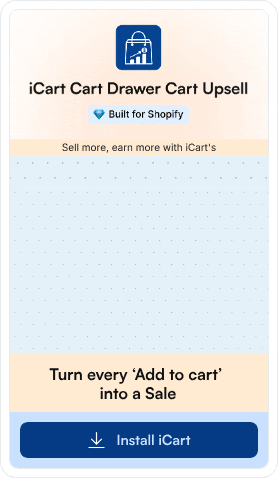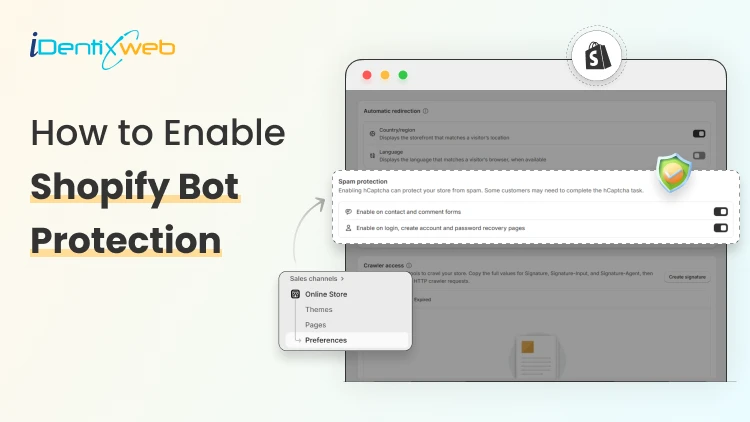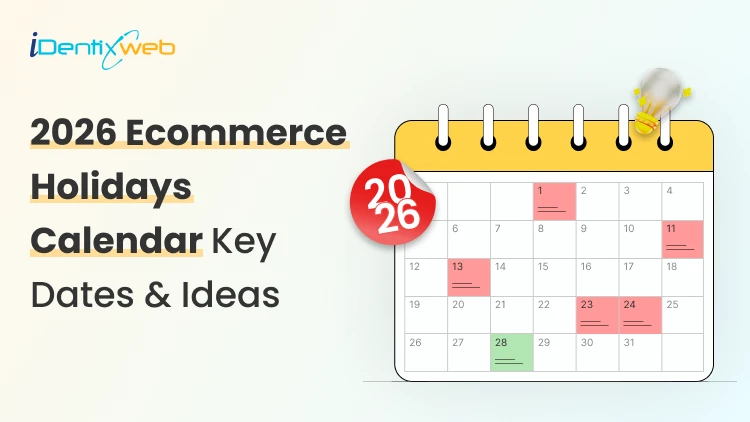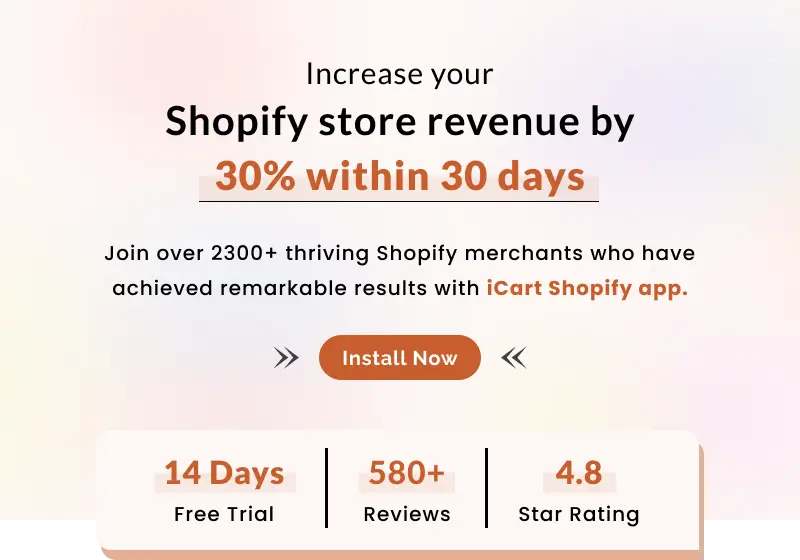![Comprehensive Guide to E-commerce Conversion Rate Optimization [2024] Comprehensive Guide to E-commerce Conversion Rate Optimization [2024]](https://www.identixweb.com/wp-content/uploads/2023/09/image4-8.png)
It's time to enter the world of online selling, where every click counts and every sale is a victory! Imagine your website as a busy marketplace that aims to convert visitors into loyal customers and draw in new ones. E-commerce Conversion Rate Optimization (CRO) can help with that; it's like giving your online store superpowers to entice and turn visitors into customers. What is the mechanism of operation, though? Let's get started and learn how to convert clicks into money!
What is E-commerce Conversion Rate Optimization?
E-commerce conversion rate optimization (CRO) is a marketing strategy that seeks to increase the percentage of website visitors who perform the desired action. Conversions, also known as desired actions, can be anything from filling out a form to purchasing a product to joining a newsletter.
To determine what is effective and ineffective, you analyze statistics and user behaviour on your website. After that, you test many aspects, such as the appearance of your website, the ease of finding items on it, or the price of items, and gradually improve them. This increases the number of sales from your website, bringing in more revenue.
First, identify the number of individuals who have purchased from your website. Then, try different ideas to determine if they perform better than your current ones. For example, try different versions of your website to discover which promotes more sales. When more customers purchase from your website, you know it has improved.
However, let's take a quick look back. When you've properly optimized your content, how do you determine which type of conversion to enhance next?
What is a Conversion?
When someone visits your website or engages with your marketing material and does the desired action, that is called a conversion. For e-commerce sites, this typically translates to converting website visitors into customers who make purchases and show interest in your business. This could be placing an order, adding items to a wish list or basket online, providing their email address, or even clicking a link in a blog post or advertisement. It is dependent upon your desired outcome. To reach your goals, you can monitor these actions and improve them.
What is the Average Conversion Rate for E-commerce?
The average conversion rate for e-commerce shows the percentage of users who take a specific step after viewing an advertisement, going to a website, or getting an email. Usually, an e-commerce website's order conversion rate ranges between 2.5% and 3%.
Several factors influence conversion rates, including the quality of the offer, the clarity of the call to action, the design of the page or ad, and the overall user experience. A well-designed, easy-to-navigate website with a compelling offer is more likely to have a higher conversion rate than one that needs to be more precise and attractive.
Enhancing website design, improving marketing tactics, and offering top-notch customer support are common ways businesses try to increase conversion rates. They can identify what appeals to their audience the most and eventually boost conversion rates by trying different aspects like headlines, photos, and button colours. Businesses can eventually contribute to their success and expansion by raising conversion rates because they can make more revenue from their current marketing and customers.
How to Calculate the Conversion Rate?
Conversion rates are crucial for businesses to understand the success of their marketing campaigns. A conversion rate counts the number of visitors or leads that complete the targeted activity. Here is a quick reference for calculating conversion rates:
Define Your Conversion Goal
You should decide what action you want your visitors to take. Among the steps could be making a purchase, signing up for a newsletter, filling out an application, etc.
Get the Total Number of Visitors
Determine how many people visited your website or landing page overall throughout a particular period. Website analytics tools, such as Google Analytics, can provide this data.
Collect Information
Track the number of individuals who came to your landing page or website and who completed the required action.
Analyze and Improve
If your conversion rate is lower than desired, analyze your website or landing page to identify potential issues. It could be confusing navigation, unclear messaging, or a complicated checkout process. Make necessary improvements and track the changes in your conversion rate over time.
Calculate Conversion Rate
Once you have your data, this is an easy calculation. Apply the subsequent formula: Conversion Rate = (Number of conversions total visitors)x 100%. For instance, your conversion rate would be the following: 500 people visited your online store last month, and 50 bought something: 10% is the conversion rate (50 ÷ 500) times 100%.
Analyze and Interpret Results
Following the conversion rate calculation, evaluate the outcomes to assess the success of your marketing and sales initiatives. A higher conversion rate suggests that your tactics successfully get visitors to complete the intended action. On the other hand, a lower conversion rate can point to areas where your website's design or marketing strategy needs work.
Optimize Strategies
To improve your strategies, apply the knowledge from examining your conversion rate. Try various marketing strategies, enhance user experience on your website, or improve the products you sell to boost conversions.
Monitor Regularly
Several variables, including modifications to marketing tactics, shifts in seasonal patterns, and outside events, can cause these rates to vary over time. As such, you must constantly monitor your conversion rate and modify your strategy.
Metrics to Measure E-commerce Conversion rate
Understanding how well your online store converts visitors into customers depends on its e-commerce conversion optimization metrics. Here are some basic metrics to think about:
1. Average Order Value (AOV)
This measures the average amount customers spend in a transaction. A higher AOV indicates that customers are purchasing more, which is good for your business.
2. Cart Abandonment Rate
This shows the percentage of visitors who add items to their cart but leave without completing the purchase. A high abandonment rate may indicate issues with your checkout process or pricing.
Read more about How to Reduce Cart Abandonment Rate
3. Bounce Rate
This measures the percentage of visitors who leave your website without taking any action. A high bounce rate could indicate your website isn't engaging or relevant to visitors.
4. Click-Through Rate
The click-through rate, or CTR, is the percentage of users who click on a particular link, advertisement, or call-to-action compared to the total number of views. It facilitates determining how well your commercial or content engages the target audience. Divide the total clicks by the total impressions (views) to get the click-through rate (CTR), then multiply the result by 100.
E-commerce Conversion Rates Optimization Checklist
E-commerce conversion rate optimization involves a multifaceted approach that addresses various aspects of the user experience, website design, and marketing strategies. Here's an e-commerce conversion rate optimization checklist to guide you through the process:
1. High-Quality Product Images
Provide crisp, high-definition photos of your items. Because buyers prefer to view things in person, ensure your photos present them in the best possible way.
2. Detailed Product Descriptions
Write thorough and informative product descriptions for every item you sell. Provide customers with features, advantages, and relevant information to assist them in making well-informed selections.
3. Simple Navigation
Keep your website simple to navigate. Customers need no trouble and rapid access to what they're looking for. Use a search bar for ease of use and categorize your products.
4. Mobile Optimization
Implement mobile optimization to make your website mobile-friendly. Many people purchase on tablets or smartphones, so ensure your website works and looks fantastic across all devices.
5. Clear Call-to-Action Buttons
Use eye-catching call-to-action buttons, like "Add to Cart" or "Buy Now." Make them prominent and easy to find on your product pages.
6. Customer Testimonials and Reviews
Displaying customer reviews and testimonials helps boost confidence and genuineness. Good reviews have the power to influence potential customers to buy.
7. Offer Sales and Discounts
Everyone enjoys a good deal! To entice people to buy from you, offer discounts, promotions, or free delivery.
8. Visible Contact Information
Ensure that your contact details are prominently displayed. If they have any issues or concerns, give them options to contact you by phone, email, or live chat.
9. Streamlined Checkout Process
Simplify the checkout procedure to reduce the chance of cart abandonment. Decrease the number of steps necessary to complete a purchase.
Read more about Shopify Checkout Optimization Tips
10. Secure Payment Options
Provide customers with ease when they make purchases by providing secure payment choices. Display trust badges and SSL certifications to reassure customers that their financial information is secure.
11. Upselling and cross-selling
Recommend complementary or related products to encourage customers to add more items to their cart, which can increase the average order value. On Shopify, you can find an app called iCart Cart Drawer Cart Upsell. With this app, you can easily upsell, cross-sell, and feature items.
12. Tailored Suggestions
Utilize data analytics to provide tailored product suggestions predicated on customers' past browsing and purchasing activities. Customization can boost sales and improve the buying experience.
13. Reduce Loading Speed
Make sure your website loads rapidly. Slow loading times may frustrate customers and increase their bounce rate. To increase loading speed, reduce the number of plugins, optimize pictures, and use caching.
14. Simplified Checkout Method
Reduce the number of stages in the checkout procedure. Avoid requesting pointless information and provide guest checkout choices to expedite the process.
15. Test Different Website Pieces
Use Shopify A/B testing to test headlines, graphics, CTAs, pricing schemes, and other pieces to find the best ones for drawing visitors in and increasing conversions.
Also read Shopify A/B Testing: Everything You Need to Know About
16. Implement Abandoned Cart Recovery
Set up a plan to contact customers who have added products to their carts but haven't finished their purchases to retrieve abandoned carts. To encourage them to come back and complete their transaction, send them emails as reminders or offer discounts.
17. Social Proof
Present social proof in numbers, such as the quantity of products purchased or the number of satisfied customers. This might create a sense of urgency and motivate people to buy.
Read more about How to Add Social Proof
18. User-generated Content
Encourage clients to post images or reviews of your products on social media platforms to create user-generated content. This can increase potential customers' brand awareness and trust.
19. Update Content Frequently
To keep your website interesting and lively, update content frequently. You can also add new products, highlight special offers, and highlight promotions. This lets clients know that your store is up-to-date and operational.
20. Post-Purchase Follow-up
After a customer makes a purchase, remember to stay in touch with them. To entice them to make another purchase, send them a thank-you note, ask for feedback, or provide a discount.
The Final Word
A well-executed website is essential to the short- and long-term success of retail and e-commerce enterprises, as online shopping has become increasingly important. Increasing ecommerce conversion rate optimization should be the top focus for businesses, as it motivates people to do what matters most—buy your products.
So, keep improving and making tweaks as you watch your online store reach new heights. After all, there's always a potential for greatness with every click in the digital era!
Faqs:
1. What is a good e-commerce conversion rate?
Average ecommerce conversion rates are typically 2.5% to 3%. Starting at 2.5% is good, but aim to boost it with conversion tactics.
2. How to increase the conversion rate of ecommerce?
Optimizing website design, simplifying checkout processes, improving product descriptions, and offering incentives can increase e-commerce conversion rates.
3. How is the e-commerce conversion rate calculated?
The E-commerce conversion rate is calculated by dividing the number of conversions by the total number of visitors and multiplying by 100 to get a percentage.





![District Shopify Theme Review: Pros, Cons, & Features [2026] District Shopify Theme Review: Pros, Cons, & Features [2026]](https://www.identixweb.com/wp-content/uploads/2025/12/25-12-Thu-Blog-District-Shopify-Theme-Review-Pros-Cons-Rating.webp)



About the author
Bidisha Saha
Step into the content world with Bidisha Saha, a seasoned Senior Content Writer at Identixweb. Passionate about e-commerce, technology, and marketing, she optimizes online visibility, crafting engaging content for business growth. Join the journey through words and innovation with Bidisha.